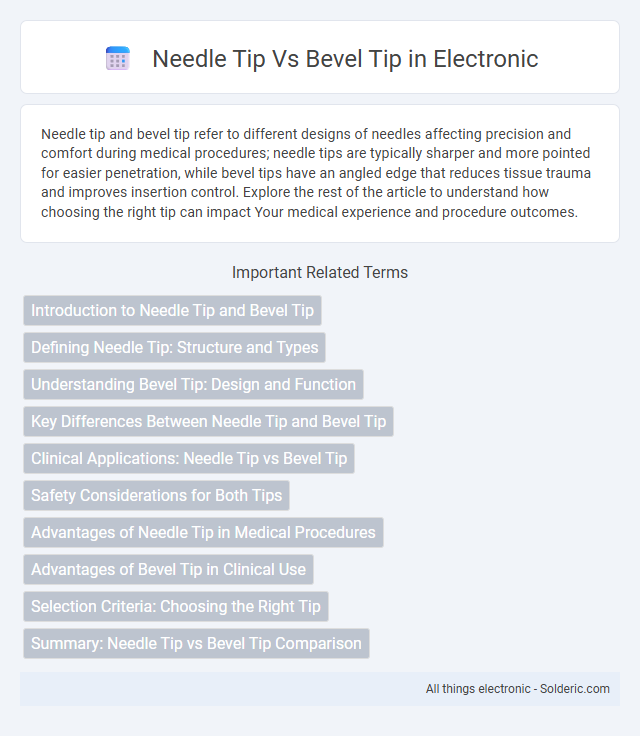Needle tip and bevel tip refer to different designs of needles affecting precision and comfort during medical procedures; needle tips are typically sharper and more pointed for easier penetration, while bevel tips have an angled edge that reduces tissue trauma and improves insertion control. Explore the rest of the article to understand how choosing the right tip can impact Your medical experience and procedure outcomes.
Comparison Table
| Feature | Needle Tip | Bevel Tip |
|---|---|---|
| Design | Sharp, pointed end for piercing | Angled, slanted edge to ease skin entry |
| Function | Penetrates tissue sharply | Reduces insertion force, improves flow |
| Applications | Injections, blood draws | IV catheters, infusion sets |
| Pain & Trauma | May cause more discomfort | Minimizes pain & tissue damage |
| Flow Rate | Standard fluid flow | Enhanced fluid dynamics |
| Usage | Common in syringes and hypodermic needles | Preferred for vascular access devices |
Introduction to Needle Tip and Bevel Tip
Needle tips and bevel tips serve distinct roles in medical and industrial applications, with needle tips designed for precision puncturing and bevel tips optimized for smooth entry and minimal tissue damage. The needle tip features a sharp, pointed end to facilitate penetration, while the bevel tip is angled to reduce resistance during insertion. Understanding the differences between these tips helps you select the appropriate tool for procedures requiring accuracy and patient comfort.
Defining Needle Tip: Structure and Types
Needle tips are precision-engineered components characterized by their pointed ends designed for specific medical or industrial applications. The structure of needle tips varies primarily between needle tips and bevel tips, where needle tips often have a straight, tapered design optimized for penetration, while bevel tips feature angled cuts to facilitate smoother entry and reduced tissue damage. Common types of needle tips include sharp needle tips for injections, blunt needle tips for safer handling, and bevel tips that enhance precision in procedures like venipuncture and biopsies.
Understanding Bevel Tip: Design and Function
Bevel tip needles feature an angled edge designed to easily penetrate tissue with minimal discomfort and precise control. The slanted bevel reduces resistance, allowing for smoother insertion and improved accuracy during injections or withdrawals. Understanding your needle tip design, especially the bevel angle, enhances the effectiveness of medical procedures and patient comfort.
Key Differences Between Needle Tip and Bevel Tip
Needle tips feature a sharp point designed for precise puncturing and minimal tissue damage, making them ideal for injections and blood draws, while bevel tips have angled edges optimized for smoother insertion and controlled fluid flow. The needle tip's focus is on penetration efficiency, whereas bevel tips enhance fluid dynamics and reduce resistance. Your choice between needle and bevel tips depends on the required medical procedure and desired balance between sharpness and fluid control.
Clinical Applications: Needle Tip vs Bevel Tip
Needle tips and bevel tips serve distinct clinical applications depending on the required precision and tissue interaction. Needle tips are primarily used for penetrating tissue with minimal trauma, making them ideal for injections and biopsies, while bevel tips provide a sharper edge designed for controlled incisions and fluid drainage in surgical procedures. Your choice between them affects patient comfort and procedural efficacy, emphasizing the importance of selecting the appropriate tip type for specific clinical needs.
Safety Considerations for Both Tips
Needle tip safety considerations include minimizing tissue damage and reducing pain by selecting appropriate size and sharpness. Bevel tip safety emphasizes precise control to avoid vessel trauma and ensuring smooth entry to reduce bleeding risk. Proper technique and sterile handling are critical for both tips to prevent infection and ensure patient safety.
Advantages of Needle Tip in Medical Procedures
Needle tips provide exceptional precision and control in medical procedures, allowing for minimally invasive treatments with reduced tissue damage and faster patient recovery. Their sharp, slender design enhances accuracy in injections and biopsies, lowering the risk of complications and improving overall procedure efficacy. You benefit from greater comfort and decreased pain during interventions when needle tips are used compared to bevel tips.
Advantages of Bevel Tip in Clinical Use
Bevel tip needles offer enhanced precision and reduced tissue trauma due to their angled, sharp design, facilitating smoother insertion and minimizing patient discomfort. Their design improves fluid flow dynamics, allowing for more controlled aspiration or injection, which is critical in delicate procedures. The bevel tip's superior visibility under ultrasound guidance enhances accuracy in needle placement, making it preferable for vascular access and regional anesthesia.
Selection Criteria: Choosing the Right Tip
Selection criteria for needle tip versus bevel tip focus on the procedure type, tissue characteristics, and intended precision. Needle tips offer controlled penetration ideal for subcutaneous injections and delicate tissues, while bevel tips provide smoother entry and reduced trauma in intramuscular or vascular access. Optimal tip choice enhances patient comfort, accuracy, and overall procedural success.
Summary: Needle Tip vs Bevel Tip Comparison
Needle tips are designed for precise fluid control and accurate injections, featuring a pointed end that minimizes tissue damage. Bevel tips have an angled edge that facilitates smoother penetration by reducing insertion force and enhancing patient comfort. Both tip types are selected based on application needs, where needle tips prioritize accuracy and bevel tips improve ease of entry and reduce trauma.
Needle tip vs bevel tip Infographic

 solderic.com
solderic.com